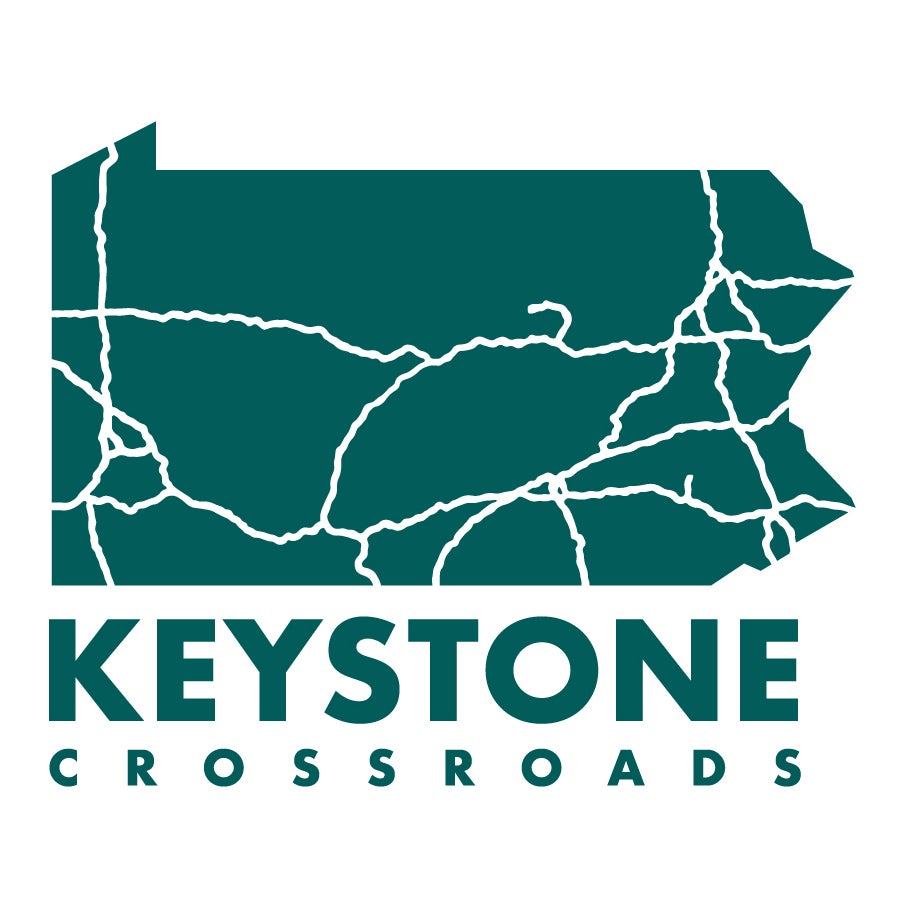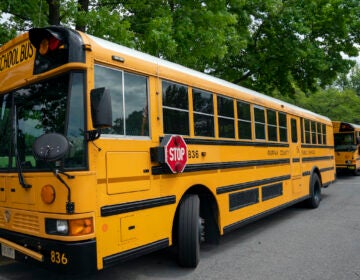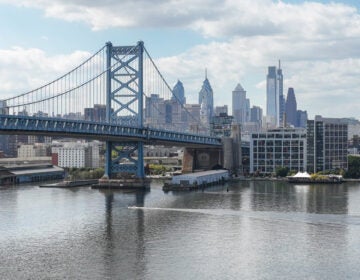Public jobs recovering slower than private sector, straining basic gov’t operations
Effects range from service cuts to an added strain on existing workers, with some municipal operations struggling to function in their basic duties.

Parkway Central Branch of the Free Library of Philadelphia (Miguel Martinez for Billy Penn)
Grass left uncut. 911 calls that just ring. Reduced hours at libraries and pools.
Federal data shows that local and state government jobs are returning more slowly than those in the private sector during the pandemic recovery. In Pennsylvania, government jobs are down 6.2% compared to pre-pandemic, excluding education workers, according to a recent analysis by the Pew Charitable Trusts.
The problem afflicts major cities and small towns. Its effects range from service cuts to an added strain on existing workers, with some municipal operations struggling to function in their basic duties.
In Philadelphia, overall employment of salaried workers declined from 28,543 in summer 2019, to 27,757 at the end of 2020, a drop of 786 people, according to city spokesperson Joy Huertas. Between the fourth quarter of FY2019 and FY2021, the decline was 3.1%.
Some of the departments that felt the losses were police and library staff.
The Philadelphia Police Department has about 370 officer vacancies, according to Fraternal Order of Police spokesperson Michael Neilon.
The department shut down its recruitment pipeline during the pandemic. Combined with staff departures and what the International Association of Chiefs of Police called a “recruiting crisis” that existed pre-pandemic, Neilon said the force is in a “crunch” and “behind the 8 ball.” He also blamed recruitment competition from suburban departments and a political culture in Philadelphia that he sees as unfriendly to cops.
The academy is now taking new recruits, but it will take about 10 months for those new hires to hit the ground. The police department did not respond to a request for comment.
Staffing shortages have also hit police dispatchers. Calls placed to 9-1-1 sometimes ring for minutes before someone is available to answer, reported Billy Penn.
It’s not just public safety.
The Free Library saw officially budgeted positions decline slightly, from 773 to 728 between FY21 and FY22, a drop of 45 employees, according to spokesperson Alix Gerz. Those positions declined through attrition.
But that’s not the whole story, according to members of the librarian’s union, AFSCME DC47 Local 2187. A decade after the Great Recession, the Free Library was down 22% over 2008 staff numbers. Then, it dropped again. “It’s the pandemic that has taken us from skeletal crews to basically, like, starving,” said chief steward and librarian Adam Feldman.
At the start of the pandemic, the Free Library laid off 207 temporary, part-time employees, in addition to the other full-time positions that were not replaced, according to Philadelphia Budget Office figures. Most branches are only open five days a week, and hours can be unpredictable because there is no one to fill in when someone calls out sick, according to the steward.
Library spokesperson Kaitlyn Foti told the Inquirer over the summer it would need to hire 60 people to fully reopen, something Feldman said has not happened.
Instead, low-staffing also takes a bite out of library programming. “Whether it’s like a cooking class, or a lecture in philosophy, or a G.E.D. class, or a class for new Americans to pass their citizenship exams, all of those things are slowed down, hampered, put on pause, more complicated by just not having enough people,” said Feldman.
Labor shortages have also wreaked havoc on school districts across the region, with a lack of commercial drivers causing unreliable bussing services and unsanitary schoolyards overflowing with trash in the School District of Philadelphia.
Sanitation is one area where worker ranks have grown, but service still suffers. Philadelphia workforce data shows 112 new salaried staffers joined the Streets Department since early 2020.
Omar Salaam, business manager for AFSCME District Council 33, which represents sanitation workers, said the increase is still not enough to fill staffing needs.
Behind that top level number is significant churn, as previously reported by WHYY, as well as a 30% average daily rate of absenteeism with the department requiring mandatory overtime to fill holes.
Similar stories are playing out in small-town Pennsylvania as well.
Amy Farkas, municipal manager for Harris Township in Centre County, described her position as being the “town mom.”
The Central Region Council governments, a group that serves the six municipalities around State College, had trouble finding seasonal staff. Without enough lifeguards or seasonal maintenance workers, there were limited pool hours and complaints from residents.
In order to attract new hires for the public works department, her municipality has raised salaries to $18/hour — up from $15/hour for jobs clearing snow and paving roads.
Farkas is also president of the Association for Pennsylvania Municipal Management. In that role, she has heard from a number of smaller municipalities around the commonwealth also facing difficulty hiring staff.
Many have struggled to find part-time staff, she said, citing Nether Providence in Delaware County as one example.
“They think pay is the problem,” she said. Some townships are combining part-time jobs into full-time ones, in hopes that will be more enticing.
Why is this happening?
Budget uncertainty, challenging work environments, and a desire for flexibility all have an impact on public sector employment.
On the whole, the number of private sector jobs has grown in 2021, but the amount of government jobs has actually shrunk, according to data from the Bureau of Labor Statistics.
That’s not due to lack of money flowing to prop up local government budgets. The American Rescue Plan Act provided $350 billion to state, local and tribal governments, with the express purpose of defraying pandemic service cuts, which include those caused by layoffs or job losses. But they also started from a deep hole, with 1.3 million fewer workers than pre-pandemic as of this spring, according to the U.S. Treasury Department.
Philadelphia alone received $276 million in CARES Act funding in 2020, more than one-third of which went to fund the Philadelphia Police Department, Fire Department, Department of Prisons, and Department of Public Health. This year, the city was allocated $1.4 billion from the American Rescue Plan Act’s State and Local Fiscal Recovery Funds, with the stated aim of helping to fill pandemic job losses.
“It’s not that governments don’t have the budget to bring back workers and a lot of cases, it’s just that they’ve been unable to,” said Mike Maciag, who crunched government job numbers for Pew.
Philadelphia officials said hiring needs fluctuate seasonally, and that COVID-19 impacts are hard to isolate. The city also had a hiring freeze for all of fiscal year 2021, with exceptions for core government and public safety needs.
In Pennsylvania, not only are government jobs down more than most other states, but private sector jobs are also recovering more slowly than the country’s average on the whole, said Maciag.
The reasons for the decline differ on the location and circumstances. Workers furloughed at the start of the pandemic may not have been brought back. Others, wary of COVID-19, were hesitant to perform in-person work and resigned. The number of people quitting, including public sector jobs, has increased in recent months, according to Department of Labor data. That’s combined to make the competition for workers even stiffer for jobs that have been historically harder to fill compared to the private sector, even as some wages have risen.
“Public employers are frequently facing an uphill battle — not only recruiting new employees, but also retaining their existing staff,” said Maciag.
That’s in addition to the other factors that have been causing people to stay out of the labor market in general, including decreased access to childcare. Pennsylvania has nearly 26,000 kids on waiting lists for daycare providers, according to the advocacy group Children First, which blames the problem on low wages in the sector.
“Staffing shortages among child care programs cause staffing shortages in all other economic sectors,” said Minesh V. Pathak, executive director of the Lower Bucks County Chamber of Commerce, in a Children First statement.
Even governments that have not seen a diminished labor pool report difficulty attracting new workers. Montgomery County added staff during the pandemic to its office of public health, but still reported more retirements than normal in the past year, according to spokesperson Kelly Cofransisco.
The county has ramped up outreach to fill traditionally hard-to-hire positions, such as 9-1-1 dispatchers and correctional officers. “We have engaged in more tactics to recruit for these positions including walk-up employment events … print and digital ads, and other outreach efforts to encourage applications,” said Cofransisco.
Getting better at recruitment may be one other effect of the pandemic, just like the growth in remote work and the ubiquity of Zoom. Across the country, some government jobs now come with a signing bonus, reported Bloomberg CityLab.
“We were forced into a situation where we had to learn how to function more like a private business,” said Farkas. At the same time, public service often comes with the expectations of in-person work, an acknowledgment that if a member of the public walks into a government building, “we’re going to be here to help them in some manner.”

Get more Pennsylvania stories that matter
WHYY is your source for fact-based, in-depth journalism and information. As a nonprofit organization, we rely on financial support from readers like you. Please give today.





![CoronavirusPandemic_1024x512[1]](https://whyy.org/wp-content/uploads/2020/03/CoronavirusPandemic_1024x5121-300x150.jpg)


